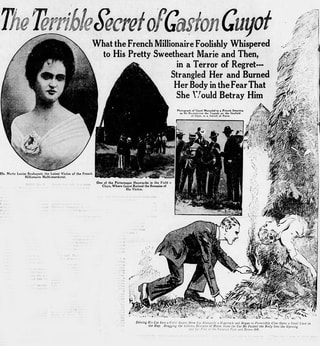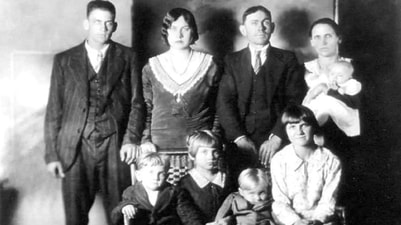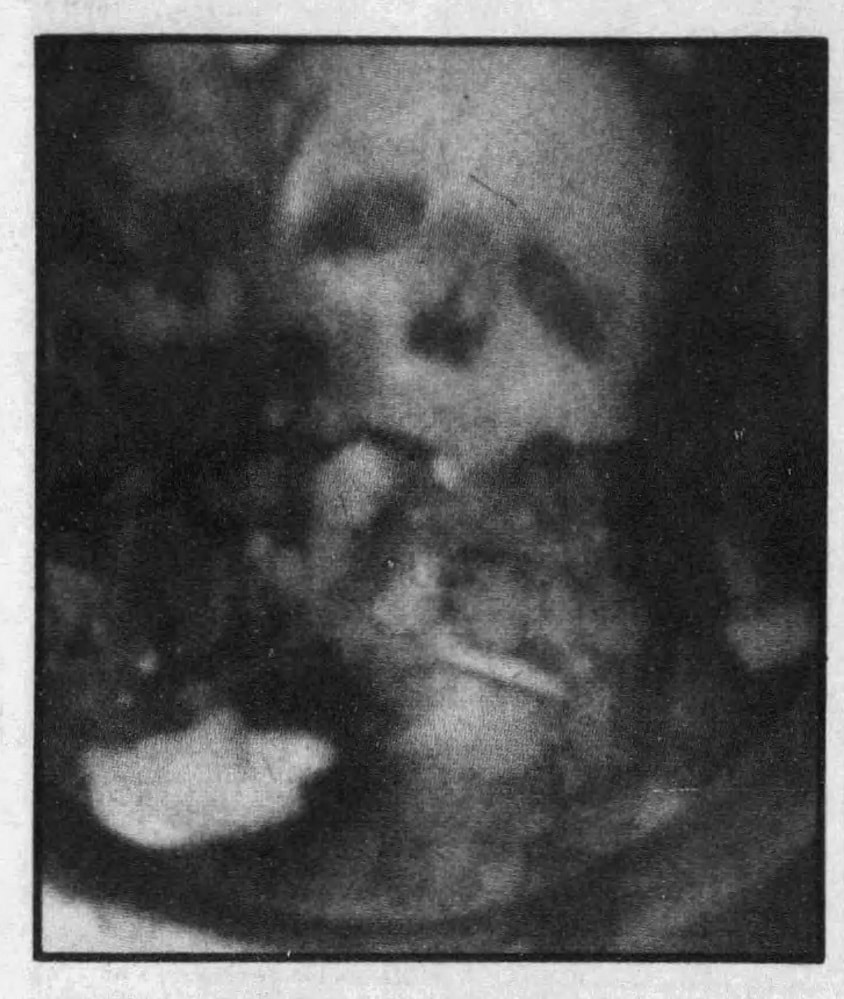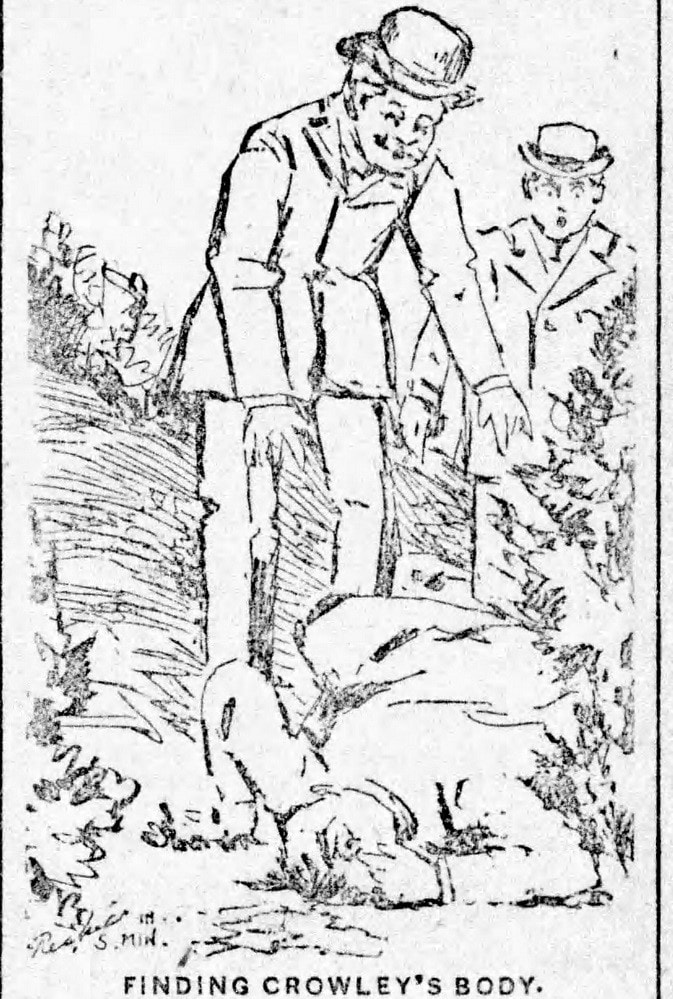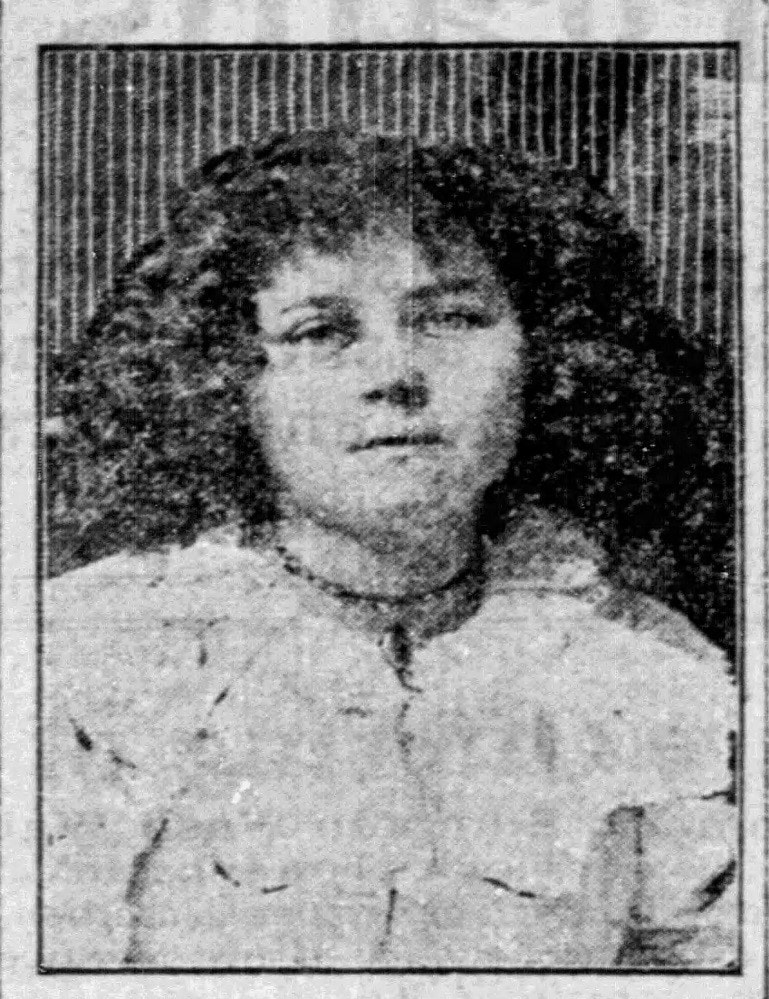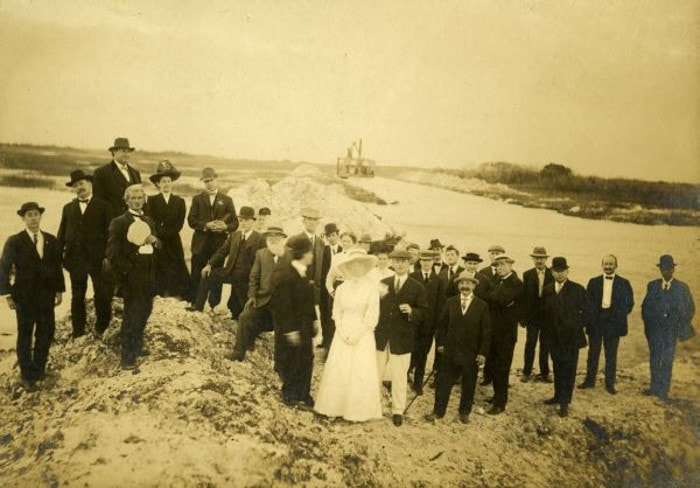Showing posts with label historical crime mystery. Show all posts
Showing posts with label historical crime mystery. Show all posts
Saturday, November 29, 2025
Monday, November 17, 2025
Monday, July 21, 2025
Sunday, April 27, 2025
The Treacherous Tennis Player | M.P. Pellicer
Vere St. Leger Goold was born October 2, 1853 into a wealthy, Irish family. When he was 26 years old he became the first Irish tennis champion. His early success in sports faded, and by 1883 he turned to alcohol and opium. However it took a turn for the worse when he met Marie Giraudin, a French, twice-widowed dressmaker.
Marie and Vere married in 1891, and riddled with debt they moved to Canada in 1897. She opened a dressmaker shop, but by 1903 they were managing a laundry business in Seacombe-on-Mersey, Liverpool. Despite their common occupation, they adopted the title of Sir Vere and Lady Goold.
READ THE REST The Treacherous Tennis Player | M.P. Pellicer:
Saturday, April 19, 2025
Mrs. Bluebeard | M.P. Pellicer
Mrs. Bluebeard | M.P. Pellicer:
Thursday, March 13, 2025
Eerie News with M.P. Pellicer | January 7, 2025
- The Cult of the Death Bat God
- Crime on the Cariboo
- The Detroit Ax Murder
- Classified CIA Experiment Claims Life Did Exist On Mars And They Built Pyramids
Host - M.P. Pellicer
www.MPPellicer.com
SUPPORT VIA DONATION
Buy Me A Coffee - https://bit.ly/3SZFf6c
Miami Ghost Chronicles: http://bit.ly/MiaGhostChron
Nightshade Diary: https://bit.ly/3WuER2z
Stories of the Supernatural: https://bit.ly/3td5sDX
MY BOOKS:
Amazon: https://amzn.to/3UljpLr
Goodreads: https://bit.ly/3NxXXjX
WHERE TO FIND ME:
Substack: https://bit.ly/3WtqjjG
YouTube: https://bit.ly/3fwo0f2
Bitchute: https://bit.ly/3zAHZ2L
Rumble: https://bit.ly/3fwewjY
Twitter: https://bit.ly/3SUZAti
Clout Hub: https://bit.ly/3DTukqi
Steemit: https://steemit.com/@miamighostchron/posts
Hypnosis - https://www.hypnosis-diy.com
Music - Pixabay.com, Purple-Planet.com
Narration always by a human, no A.I.
Tuesday, February 18, 2025
The Skeletons in the Cave | M.P. Pellicer
In July 1945, the battle of Okinawa took place, leaving over 200,000 dead, among them over one-third of civilians who lived on the island. Okinawans had been forced to commit suicide by the Japanese military or be executed. Lawlessness was rampant on the island and refugees lived in the hills. A month later atomic bombs would fall on Hiroshima and Nagasaki and amid this turmoil the disappearance of three young Marines was barely noticed.
Their names were James D. Robinson (Savannah, Ga.), John M. Smith (Cincinnati), and Isaac Stokes (Chicago). Initially they were listed by military as deserters and then they were declared missing in action. They were all 19 years old.
Tuesday, December 31, 2024
Crime on the Cariboo | M.P. Pellicer
Historically whenever gold is discovered, it's rapidly followed by a swell of strangers all vying to strike it rich. With it comes opportunity, but also trouble, and even murder.
Cariboo, British Columbia
In 1862, Nehemia T. Smith, better known as Blackjack was involved in the discovery of gold in the Cariboo mines, and the famous strike on William Creek. He had been part of the Fraser River Gold Rush in 1858.
READ THE REST Crime on the Cariboo | M.P. Pellicer:
Monday, October 28, 2024
The Valentine's Day Ritual Murder | M.P. Pellicer
On a cold February evening in 1945 the body of 74-year-old Charles Walton was found in a field of the Firs farm, in which he had been working earlier that same day. He was considered a recluse, and no one who lived in the Warwickshire hamlet could understand who would want to kill him, much less mutilate him.
Charles Walton was known to be a quiet man and a loner, who shared a thatch-roofed cottage opposite the village church with his niece in the hamlet of Lower Quinton. Despite suffering from rheumatism and using two walking sticks, he worked on and off doing odd jobs and lived off his small pension. His reputation as an honest, hardworking farm laborer left the authorities puzzled as to who would want to kill him, especially in such a brutal manner.
Tuesday, August 27, 2024
The Ghost of Al Capone's Mistress | M.P. Pellicer
Capone had many mistresses, but some held his interest longer than others. One of these allegedly was Mary Ann Brown, who also went by the name of Vera. She is a mysterious woman, because very little is known about her, if she ever existed at all.
Perhaps she used the surname of Brown in imitation of Capone's alias Al Brown, which he used since 1920 when he was the keeper of the Four Deuces saloon at 2222 S. Wabash Avenue. Later in life he would be known by the more notorious moniker of Scarface.
READ THE REST The Ghost of Al Capone's Mistress | M.P. Pellicer:
Sunday, July 21, 2024
The Fate of the Grave Digger | M.P. Pellicer
Criminals are sometimes undone by their stupidity or desperation, but there are others who are discovered by sheer bad luck. Such is the case of a gravedigger named Jean Baptiste.
Utah, 1862Four men were arrested, and two were sought in an assault upon John W. Dawson (1820-1877) the governor of Utah who had been nominated to the post by Abraham Lincoln. One of these men was named Moroni Clawson. Ironically three weeks before they had been hired to protect the governor until he reached the eastern boundary of the Utah territory, but then something changed.
Saturday, July 20, 2024
Lord of the Jackals | Sax Rohmer | Nightshade Diary Podcast
Host - M.P. Pellicer
www.MPPellicer.com
SUPPORT VIA DONATION
Buy Me A Coffee - https://bit.ly/3SZFf6c
Miami Ghost Chronicles: http://bit.ly/MiaGhostChron
Nightshade Diary: https://bit.ly/3WuER2z
Stories of the Supernatural: https://bit.ly/3td5sDX
MY BOOKS:
Amazon: https://amzn.to/3UljpLr
Goodreads: https://bit.ly/3NxXXjX
WHERE TO FIND ME:
Substack: https://bit.ly/3WtqjjG
YouTube: https://bit.ly/3fwo0f2
Bitchute: https://bit.ly/3zAHZ2L
Rumble: https://bit.ly/3fwewjY
Twitter: https://bit.ly/3SUZAti
Gab: https://bit.ly/3sVNPrY
Gettr: https://bit.ly/3UjK6jt
Clout Hub: https://bit.ly/3DTukqi
Astrology Today: https://bit.ly/astrology_today
Hypnosis - https://www.hypnosis-diy.com
Music - Pixabay.com, Purple-Planet.com
Narration always by a human, no A.I.
Monday, July 15, 2024
Esoteric Stories | Interview with Brice Watson | Stories of the Supernatural
Brice Watson is the host of Esoteric Atlanta, a channel dedicated to the exploration and celebration of all things weird in the state of Georgia and around the world! We discuss stories of ghost and conspiracy theories, not to mention interesting people and places.
Host - M.P. Pellicer
www.MPPellicer.com
SUPPORT VIA DONATION
Buy Me A Coffee - https://bit.ly/3SZFf6c
Miami Ghost Chronicles: http://bit.ly/MiaGhostChron
Nightshade Diary: https://bit.ly/3WuER2z
Stories of the Supernatural: https://bit.ly/3td5sDX
MY BOOKS:
Amazon: https://amzn.to/3UljpLr
Goodreads: https://bit.ly/3NxXXjX
WHERE TO FIND ME:
Substack: https://bit.ly/3WtqjjG
YouTube: https://bit.ly/3fwo0f2
Bitchute: https://bit.ly/3zAHZ2L
Rumble: https://bit.ly/3fwewjY
Twitter: https://bit.ly/3SUZAti
Gab: https://bit.ly/3sVNPrY
Gettr: https://bit.ly/3UjK6jt
Clout Hub: https://bit.ly/3DTukqi
Astrology Today: https://bit.ly/astrology_today
Music - Pixabay.com, Purple-Planet.com
Narration always by a human, no A.I.
Guest - Brice Watson
Website - / @esotericatlanta
Wednesday, April 3, 2024
The Millionaire and the Telephone Girl | M.P. Pellicer
Two officers of the bicycle police brigade of Fresnes-sur-Marne were patrolling the road to Claye, when they came in the night upon a smoldering hayrick in a field belonging to Farmer Ernet. Under the rick about 100 feet off the main road and up a cart track, they smelled the odor of burning flesh. It was the body of a slender girl, and it was obvious by the charring of her body someone had set her on fire.
On August 13, 1926, a Friday, the police in the French city of Freses-sur-Marne were trying to solve what was dubbed by the press as the "Friday the 13th" murder. The body of a young girl was found in a burning haystack near a lonely road. The girl was strangled and the fire was assumed to have been started to conceal the crime.
Monday, March 4, 2024
Descent into Madness | M.P. Pellicer
It was the day after Christmas, 1929 when newspapers in North Carolina carried the disturbing news of a father who had annihilated his entire family. Sixty years would pass before the motive of this heartless act would be learned.
His name was Charles Davis Lawson, and within a day of this horrific crime authorities were trying to understand what caused him to do away with his wife and six children.
Saturday, March 2, 2024
Skeleton in the Chimney | M.P. Pellicer
It was Labor Day weekend and Steve Liethen owner of the Good 'N Loud Music in Dane County, Wisconsin was fixing a water leak after a boiler was removed. When he shone a light into the chimney the last thing he expected to see was a human skull.
Dane County, Wisconsin, September 3, 1989
A construction crew made a hole at the base of the chimney to remove the remains. They also found a shoe, pieces of clothing and a 6-inch clump of intact reddish-brown hair.
Friday, March 1, 2024
Mysteries of Old Florida: Skeleton Stories | Volume 4 | Stories of the Supernatural
- Murder at Matanzas Inlet
- The Dead Man at Devil's Elbow
- The Skeleton at the Scrub
- The Missing Mr. Tod
- The Bones at Ponce Park
- Blind Tigers Always Keep Their Secrets
Host - M.P. Pellicer
www.MPPellicer.com
SUPPORT VIA DONATION
Buy Me A Coffee - https://bit.ly/3SZFf6c
Miami Ghost Chronicles: http://bit.ly/MiaGhostChron
Nightshade Diary: https://bit.ly/3WuER2z
Stories of the Supernatural: https://bit.ly/3td5sDX
MY BOOKS:
Amazon: https://amzn.to/3UljpLr
Goodreads: https://bit.ly/3NxXXjX
WHERE TO FIND ME:
Substack: https://bit.ly/3WtqjjG
YouTube: https://bit.ly/3fwo0f2
Bitchute: https://bit.ly/3zAHZ2L
Rumble: https://bit.ly/3fwewjY
Twitter: https://bit.ly/3SUZAti
Gab: https://bit.ly/3sVNPrY
Gettr: https://bit.ly/3UjK6jt
Clout Hub: https://bit.ly/3DTukqi
Music - Pixabay.com, Purple-Planet.com
Tuesday, February 27, 2024
Murrell's Protégée | M.P. Pellicer
The place was Sandtown Road, once known as the Sand Town Trail, near the West End in Atlanta where a man's skeleton was found. It was a swampy area, some distance from the road in a dense area of cane growth. Most noted that it was an "admirable spot for a murder."
Atlanta, April 12, 1897
The bones were found by a policeman's young son, and soon crowds flocked to the place. All believed the person was a victim of murder, with the body not fully decomposed. He appeared to have been a man of means. Near to the remains was a piece of a gold chain, a small silver ring and a dainty gold locket, which was in the man's pocket, and not discovered by his attacker, if theft was the motive.
Monday, February 26, 2024
Glory's Death | M.P. Pellicer
It was a spring day in 1903 when the body of Bertha "Glory" Whalen was found in a thicket. Her family had last seen her when she left for school.
Collingwood, Ontario, 1903
The Grand Trunk Railroad seemed destined to be the site of dark occurrences the year of 1903, starting in January.
Friday, February 23, 2024
Blind Tigers Always Keep their Secrets | M.P. Pellicer
Bones were found on the bank of the Miami Canal on April 12, 1917. The police immediately compared the crime to the murder of Eddy Kinsey, whose body had been discovered in similar circumstances a few months before.
What was left of the man was only a skeleton, with evidence that he was the victim of foul play. The bones were taken to Undertaker W.H. Combs. From the general appearance, the remains had been left on this lonely spot for about six months. It had been scattered by buzzards, which had cleaned away the flesh and only traces of garments were left behind. There was also a pair of tan shoes hardly used, which later were proven to have been purchased at an Avenue D shop. A burned buckle showed that he wore a leather belt around his waist.
Subscribe to:
Comments (Atom)
Popular
-
THE BLACK ISLAND | AUGUST DERLETH | PODCAST : The Black Island, Being the Narrative of Horvath Blayne" is a short Cthulhu Mythos story...
-
The Explorer's Last Adventure | M.P. Pellicer : Captain Meriwether Lewis was born into fortunate circumstances in 1774. He is best know...
-
Arthur Henry "Sarsfield" Ward (1883 – 1959), better known as Sax Rohmer, was an English novelist. He is best remembered for his se...
-
The Tomb of the Unknown Boy | M.P. Pellicer : The Roaring Twenties are remembered for speakeasies hidden in remote locations or the basemen...
-
STORIES: The Ghost of Doarlish Cashen The Messages of Fatima The Missoula Mauler "Hope For The Future": Newly Discovered 'Sup...
-
SOMETHING IN WOOD | AUGUST DERLETH | PODCAST : Evil beings from a distant dimension use the most unusual items to punch a hole into our rea...
-
Michael Cremo is the author of "Forbidden Archeology: The Hidden History of the Human Race". This book shows that archaeologists a...
-
Rob Felber discusses his latest book "The Unwelcomed: The Curious Case of Clara Fowler" that has been called “the most frightening...
-
The Ghost in the Garret | M.P. Pellicer : To all appearances Dolly and Fred Oesterrech were a dull, average couple who owned a factory. Lit...








